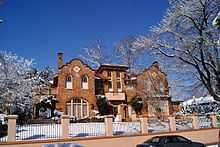Virginia-Highland
| Virginia Highland | |
|---|---|
| Neighborhoods of Atlanta | |
| Nickname(s): VaHi | |
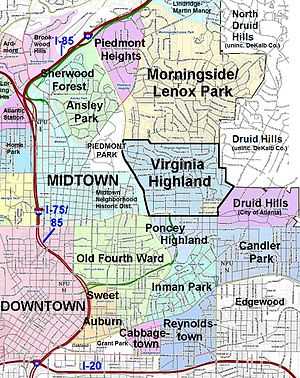 | |
| Coordinates: 33°46′56.64″N 84°21′15.48″W / 33.7824000°N 84.3543000°WCoordinates: 33°46′56.64″N 84°21′15.48″W / 33.7824000°N 84.3543000°W | |
| Country | United States |
| State | Georgia |
| County | Fulton County |
| City | City of Atlanta |
| Council District | 6 |
| NPU | F |
| Government | |
| • City Council | Alex Wan |
| Population (2010) | |
| • Total | 7,800[1] |
| ZIP Code | 30306 |
| Website | Virginia Highland Civic Association |
|
Virginia Highland Historic District | |
| Location | bounded roughly by Amsterdam Ave., Rosedale Rd., Ponce de Leon Avenue and the BeltLine, Atlanta, Georgia |
|---|---|
| Coordinates | 33°46′56.64″N 84°21′15.48″W / 33.7824000°N 84.3543000°W |
| Area | 612 acres (248 ha) |
| Built | 1899-1955 |
| Architect | A. Ten Eyck Brown, G. Lloyd Preacher, Owens James Southwell, Leila Ross Wilburn |
| Architectural style | Bungalow/Craftsman |
| Governing body | Local |
| NRHP Reference # | 5000402[2] |
| Added to NRHP | May 10, 2005 |
Virginia-Highland (often nicknamed "VaHi")[3] is a neighborhood of Atlanta, Georgia, founded in the early 20th century as a streetcar suburb. It is named after the intersection of Virginia Avenue and North Highland Avenue, the heart of a busy commercial district at the center of the neighborhood. The neighborhood is famous for its bungalows and other historic houses from the 1910s-1930s. It has become a destination for people across Atlanta with its eclectic mix of restaurants, bars, and shops and for the Summerfest festival, annual Tour of Homes and other events.
In 2011 readers of Creative Loafing voted Virginia-Highland "Best Overall Neighborhood",[4] and in June 2011, Atlanta Magazine designated Virginia Highland "favorite neighborhood overall".[5] In 2012 readers of Creative Loafing voted VaHi "Best Walkable Neighborhood".[6]
Name
Newspaper articles from the early 1920s refer to the "Virginia Highland" section of Atlanta with regard to the area around the intersection of Virginia Avenue and Highland Avenue. Later in the 1920s, southeast of this intersection the "Virginia Highlands" (with an "s") subdivision was built. However, neither term appeared again in the press until the 1970s.
During the revolt against the construction of the I-485 freeway through Morningside and what is now Virginia-Highland, a pro-highway group called themselves the "Highland- Virginia Civic Association", claiming to speak for the neighborhood. When Joe Drolet and other residents formed a group to oppose the highway in Fall 1971, they chose the name "Virginia-Highland Civic Association".[7] With the victory of the anti-highway forces, the Virginia-Highland name stuck and started to appear in the press in reference to the entire neighborhood between Amsterdam, Ponce, Piedmont Park and Druid Hills.
Around Atlanta, "Virginia-Highland", "Virginia Highlands" and "the Highlands" are all commonly heard. However, only "Virginia-Highland" is the official name of the neighborhood. The other terms are even included in some business names, but are incorrect.
The term VaHi, imitating the New York style of naming neighborhoods (SoHo, TriBeCa), first was used in the Atlanta newspapers in 1998. It is now in common use as a shortened, playful form or in URLs of neighborhood media and organizations (examples are www.vahi.org, www.vahinews.com and vahi.patch.com).

History
The first record of settlement of the area that is now Virginia-Highland was in 1812, when William Zachary bought and built a farm on 202.5 acres (0.819 km2) of land there. In 1822 he sold his farm to Richard Copeland Todd (1792–1850). Todd's brother-in-law Hardy Ivy settled in 1832 in what is now Downtown Atlanta and the road between their two farms came to be known as Todd Road (a portion of which still exists in Virginia Highland).
"Nine Mile Circle"

In the 1880s, Georgia Railroad executive Richard Peters and real estate developer George Washington Adair organized the Atlanta Street Railway Company.[8] Their first project was the Nine Mile Trolley, which started serving the area sometime between 1888 and 1890 . At first, patrons used this streetcar line to visit "the countryside" outside the city, but the line also enabled later development in the area. Adair built his home at 964 Rupley Drive (still standing and divided into upscale apartments). The iconic curves in the street at the intersections of Virginia Ave. with N. Highland and Monroe are remnants of the trolley line which required gentle curves. The Trolley Square Apartments (now "Virginia Highlands [sic] Apartments") near Virginia and Monroe were built on the site of trolley maintenance facilities.
Residential development
The first land to be subdivided in what is now Virginia Highland was Highland Park in the 1890s, located on either side of Ponce de Leon Ave. between today's Barnett St. and N. Highland Ave. However, the majority of the houses and streets in Virginia-Highland were constructed between 1909 and 1926.[9] In 1916 the Arc Light Controversy raged between neighbors on Adair Ave. and N. Highland Ave.
Commercial development
Some businesses opened around the intersection of Virginia and N. Highland starting in 1908, with many more opening starting in 1925. At the same time development started in the Atkins Park commercial district around St. Charles. Ave. and N. Highland, including in the present-day Atkins Park Restaurant (1922) which reportedly got what is now Atlanta's oldest liquor license when it became a bar and restaurant in 1927. Between 1928 and 1930, the Howard Dry Cleaning Company and the Phelps Millard Grocery opened, anchoring the Amsterdam and N. Highland business district. The Samuel N. Inman School, named after the nineteenth-century cotton merchant, was built in 1923. In 1924, fire station 19 was built on N. Highland at Los Angeles Ave.
Streetcar service to Virginia-Highland ended around 1947, along with all of the other trolley lines into and out of central Atlanta.
Decline
Virginia-Highland, like most intown Atlanta neighborhoods, suffered decline starting in the 1960s as residents moved to the suburbs. Less-affluent residents moved in, some single-family houses were turned into apartments, and crime increased. Some businesses closed and were replaced by lower-rent tenants such as pawn shops. Others, such as Moe’s and Joe’s (which opened in 1947) and Atkins Park Restaurant, stayed open. Many buildings deteriorated.
Threat and defeat of I-485
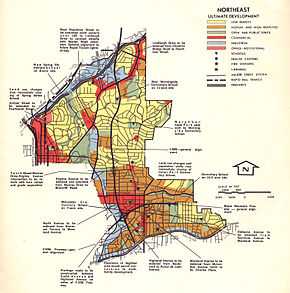
What could have been the death knell for the neighborhood sounded in the mid-1960s, when the Georgia Department of Transportation proposed building Interstate 485 to connect what is now Freedom Parkway through the neighborhood and to what is now Georgia 400 at Interstate 85. It would have included an interchange at Virginia Avenue where John Howell Memorial Park is today. Despite the I-485 proposal moving forward, a few middle-class families began moving back into the neighborhood, renovating homes.
In Fall 1971, Joseph (Joe) Drolet and others founded the Virginia-Highland Civic Association (VHCA), whose mission was to defeat I-485,[10] and registered the association with the Georgia Secretary of State on August 22, 1972.[11] They along with residents of Stone Mountain, Inman Park, and Morningside finally defeated I-485, and became a political force to be reckoned with. The current Neighborhood Planning Unit (NPU) system is an outgrowth of these events. In 2009, the original north/south freeway (connecting 675 to 400) was again put on GDOT's to-do list, but this time running in a tunnel underneath the neighborhoods, with buildings to vent exhaust fumes and smog above ground.
Between 1972 and 1975, property values increased from 20 to 50 percent. Home ownership levels rose 20 percent. A tour of renovated homes started in 1972. The Georgia Department of Transportation began selling properties it had acquired for I-485, virtually all of them for infill housing. The 3 acres (12,000 m2) of land on Virginia Avenue where 11 houses had been taken and demolished to make way for a Virginia Avenue exit, however, was finally opened in 1988 as John Howell Memorial Park, in memory of Virginia-Highland resident and anti-freeway activist John Howell, who died from complications of HIV in 1988.
During the 1970s and 1980s the VHCA also worked to improve the city's process of home inspection, to develop a resource network of quality, affordable service providers to aid homeowners in renovation, and to encourage developers to lease renovated commercial buildings “as is” at low rates in order to encourage new and unique businesses, and thus a truly distinct commercial district.
In the early 1980s, Atkins Park restaurant was renovated. Meanwhile, Stuart Meddin bought and renovated the 1925 commercial block at North Highland and Virginia.
In 1988, the turn-of-the-century trolley barns on 5 acres (2.0 ha) on Virginia Avenue on the east side of the BeltLine (today's Virginia Highland Apartments) were torn down despite the City Council and VHCA's attempts to save them. Although previously assuring local residents that he favored saving the historic structures, Mayor Andrew Young then vetoed the resolution, and the Council's vote of 11-3 was not enough to override it. Young cited the discovery of asbestos in the buildings and other hazardous materials on the property.[12][13]
Metro-wide destination
As the neighborhood continued to regentrify, property values increased rapidly; the shops and restaurants became progressively more upscale. Towards the end of the 90s, the neighborhood-oriented character of the business districts gave way to businesses serving patrons from across greater Atlanta.[14] VIrginia-Highland wrestled with traffic and parking issues. Apartments affordable to students became more difficult to find.
In 2000, a spat among organizers and a shakeup in the organizing committee made local headlines.[15] However, Summerfest did continue as usual in 2001 as one of Atlanta's highest profile neighborhood festivals.
Preservation and balance
In November 2006, the Georgia Trust for Historic Preservation added Virginia-Highland to its list of "places in peril" due to an acceleration of teardowns and infill projects by real estate developers and newcomers to the area. However, Virginia-Highland remains one of the most architecturally historic, distinct and vibrant neighborhoods in Atlanta.
Residents, through the VHCA, succeeded in getting the city council to pass zoning legislation prescribing development that fits the scale of the streets, rolling back loose zoning ordinances passed in the 1960s.[16][17] The new zoning also prescribes a maximum number of each type of establishment - restaurants, bars, retail and other types.
The zoning aims to preserve a vibrant mix of enterprises while keeping control noise, parking and traffic issues but also addresses specific problems which came up in 2005-2008:
- Avoiding Virginia Highland suffering the same fate as Buckhead Village, where a large number of bars opened, eventually attracting crime from other areas of the city.
- Fighting a liquor permit for the 700-seat Hilan Theatre[18]).
- Opposing "The Mix@841" project at 841 N. Highland Ave., originally proposed to be 80 feet tall.
In December 2008 the VHCA bought the land for New Highland Park, a small 0.41 acres (0.17 ha) park at N. Highland and St. Charles.
In Autumn 2010, a rash of seven muggings occurred, statistics which were far lower than those of the 1980s when the neighborhood was edgy, but in 2010 shaking up the neighborhood.[19] Partly in response, the local security patrol, FBAC, expanded patrol coverage to the entire neighborhood. Shortly thereafter in Nov. 2010 Charles Boyer was murdered during a mugging, for which the "Jack Boys" were indicted in Jan. 2011.[20] Police continued to step up patrols and since then Virginia Highland has returned to its status as one of Atlanta's lower-crime neighborhoods.[21]
Currently the neighborhood is enjoying adjacent development projects including a new biking and walking trail along the BeltLine from Piedmont Park to Inman Park, as well as the pending redevelopment of Ponce City Market, the old Sears building, which later became City Hall East. Ponce City Market is slated to become a major multi-use development including a gourmet food hall of national importance. Behind Ponce City Market is the brand new (2011) Historic Fourth Ward Park.
Location
Virginia-Highland is bounded on the north by Amsterdam Avenue and the neighborhood of Morningside, on the east by the Atlanta city limit/Briarcliff Road and the Druid Hills neighborhood, on the south by Ponce de Leon Avenue and the Poncey-Highland neighborhood, and on the west by the BeltLine which is the border with Piedmont Park and Midtown.[22]
Atkins Park
Within these boundaries is Atkins Park, a neighborhood listed on the National Register of Historic Places. The City of Atlanta recognizes Atkins Park as a separate neighborhood,[23] however, Atkins Park is a part of the Virginia-Highland Civic Association.
St. Charles-Greenwood
St. Charles-Greenwood had its own neighborhood association in the 1980s,[24] but was then absorbed into Virginia Highland.
Commercial districts

Virginia Highland is one of many intown Atlanta neighborhoods characterized by commercial space of two sorts:
- groups of small commercial units clustered at corner where the streetcars used to stop (e.g. N. Highland Ave. at St. Charles and Virginia)
- commercial space in former warehouses and industrial buildings, especially, but not exclusively, along the BeltLine (e.g. Amsterdam Walk and Ponce de Leon Place)
Such "streetcar corner" nodes are located at Virginia at North Highland — the neighborhood's namesake and main shopping and dining area, well known since the 1990s for its restaurants,[25] St. Charles at North Highland, Amsterdam at North Highland, and Virginia at Rosedale Drive. Amsterdam Walk, a shopping and entertainment complex built in was originally part of the Campbell Coal Company warehouse. Ponce de Leon Place also has a concentration of warehouse space converted to commercial use.
Just across the BeltLine from the western border of Virginia-Highland are two major strip malls, Midtown Place and Midtown Promenade. Adjacent is the former City Hall East, prior to that the Sears building, which is being developed into Ponce City Market, with office, retail and residential space. It is to include a nationally significant gourmet food hall, which the developer Jamestown compares to Chelsea Market in New York City, which Jamestown developed, or also to Seattle's Pike Place Market and San Francisco's Ferry Building.[26][27]
Architecture
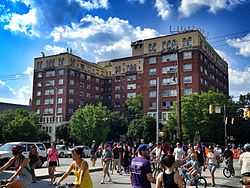
Virginia-Highland is best known for its oldest residences - the Craftsman bungalows that line the streets closest to which or on which the Nine Mile trolley ran: Virginia Avenue, North Highland Avenue, St. Charles Avenue, etc. Other architectural styles include English Vernacular Revival and Colonial Revival, and other house types include English Cottage and American Foursquare.[28]
Besides the churches noted below, some other landmarks of note are:
- Fire station 19 (1924), built in 1924 in the bungalow style. Atlanta's oldest operating fire station at 1063 N. Highland Ave.
- The Adair mansion at 964 Rupley Drive, now divided into apartments
- Briarcliff Hotel (1925) (photo), 1050 Ponce De Leon Ave. at N. Highland.
- the Hilan Theatre (1932)
- Atkins Park Tavern (1922)
- Belly, a delicatessen, formerly the Atkins Park Pharmacy (1914), later Fleeman's Pharmacy
Virginia-Highland and Atkins Park are both listed on the National Register of Historic Places (NRHP), with Atkins Park having in addition the status of historic overlay district which, unlike a NRHP listing by itself, actually provides for measures to enforce preservation. The VHCA is investigating the possibilities of designating Virginia Highland a historic overlay district as well.[29]
Law and Government
Government
Virginia-Highland is a neighborhood of Atlanta, which unlike in many other cities, are officially defined and organized and given specific areas of control. The Virginia Highland Civic Association consists of a volunteer board and oversees matters controlled at the neighborhood level such as community festivals, community safety, beautification, and efforts to improve parks, sidewalks, etc. As noted above, the Atkins Park neighborhood, while having its own neighborhoods association, participates in the VaHi association much as if it were part of VaHi. Planning, building permits, etc. are controlled by the Neighborhood planning unit F, which also includes Morningside-Lenox Park, Piedmont Heights and Lindridge-Martin Manor.
Crime prevention
Virginia-Highland serves as a model for other neighborhoods of Atlanta in implementing a comprehensive range of safety measures:
- Virginia-Highland is part of APD patrol zone 6.
- FBAC is the neighborhood security patrol, funded by members, run by volunteers and staffed by off-duty APD officers.
- The VaHi Civic Association organizes a neighborhood watch program via its Safety Team.
- VHAlerts is a system which leverages the text-message features of Twitter to allow members to text-message all other members in case of a dangerous situation in the neighborhood.
Culture and Recreation
Parks
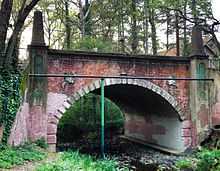
Virginia-Highland borders:
- Atlanta's landmark Piedmont Park (vastly expanded in 2011)
- the BeltLine, a former railroad line, now a 22-mile trail around the central neighborhoods of Atlanta. The BeltLine features dozens of outdoor artworks along its length through the Art on the BeltLine project.
Within the boundaries of Virginia-Highland are:
- John Howell Memorial Park, along Virginia Ave. between Barnett and Arcadia Streets
- Orme Park, bounded by Brookridge Dr. and Elkmont Dr., through which Clear Creek runs
- New Highland Park, which the civic association bought in 2008 and were developed in 2012 as an eco-friendly park and rain garden[30]
"Neighborhood Arboretum"
Virginia-Highland has one of seven Atlanta "neighborhood arboreta", which are in fact walking routes of trees (identified by markers) in yards, sidewalk planting strips, and parks. A brochure maps out the route and the trees along each route, as well as educating visitors about the trees.[31]
Festivals

The VHCA hosts the yearly Virginia-Highland Summerfest arts and music festival, one of the largest art festivals in the Southeastern United States and one of Atlanta's most popular neighborhood festivals. VHCA also organizes the annual Virginia-Highland Tour of Homes. In May, Taste of the Highlands in John Howell Park features samplings from favorite neighborhood restaurants and live music.
Film and television
Portions of the films Life as We Know It (the bakery portrayed was the real-life Belly General Store) and Trouble with the Curve (George's restaurant) were filmed in Virginia-Highland. Portions of the pilot for the "B.E.T." network's Being Mary Jane were filmed at 780 N. Highland Ave. in April 2012.[32][33]
Religion
Virginia-Highland is home to a number of churches:
- Church of Our Saviour (Anglo-Catholic Episcopalian) - current building mid-1930s
- Druid Hills Presbyterian Church - built 1923, expanded 1940, 1963
- First Associate Reformed Presbyterian Church - built 1924
- Virginia Highland Church (formerly Baptist) - built 1923
The Chabad Intown synagogue is located on Ponce de Leon Avenue.
Eruv
The Virginia Highland eruv covers nearly all of Virginia-Highland as well as part of the Morningside-Lenox Park neighborhood up to E. Rock Springs Road/E. Morningside Drive.[34] The eruv is "marked off" by defining utility poles as "sides of the doorways" and the wires as the "lintels" (tops of doorways). Within its boundaries observant Jews are allowed to do certain things on the Sabbath that they would not normally be allowed to do outside the home, such as carry keys or food.[35]
Education

The community is zoned to Atlanta Public Schools.
Zoned schools include:
- Springdale Park Elementary
- Inman Middle School
- Henry W. Grady High School
Transportation
Virginia-Highland is served by the following MARTA bus routes which also connect it to MARTA rail lines:
- 2 along Ponce de Leon to North Avenue rail station or to both Inman Park and Candler Park/Edgewood rail stations
- 6 along Briarcliff to Emory or to Inman Park rail station
- 16 along N. Highland (southbound turns onto Ralph McGill ending at Five Points rail station)
- 36 from Midtown rail station, Virginia Avenue, north on N. Highland, east on Decatur to Emory, Decatur and Avondale rail station
- 99 west from Monroe and Virginia along 10th Street to Midtown rail station; south from Monroe and Virginia along Boulevard
The neighborhood was long served by streetcar line #15 which later became bus line #45.[36] Line 45 was discontinued in 2010.
Noted residents
Noted residents of Virginia Highland, past and present, include:
- Margaret Edson, 1999 Pulitzer Prize winner for the play Wit, as of February 2012 a social-studies teacher at Inman Middle School[37]
- Don Lemon, CNN journalist, author
- Isabel Wilkerson, author of The Warmth of Other Suns, the story of African American migration from the South to the North[38]
- Dr. Leila Denmark lived on Kentucky Avenue and then Hudson Drive in the 1930s and 1940s. Dr. Denmark was the world's oldest practicing pediatrician until her retirement in May 2001 at the age of 103.[39] At her death in 2012 she was the 4th-oldest verified living person in the world.
- Green B. Adair (c. 1837-1914), fertilizer magnate, had his summer house at what is now the Adair Mansion from 1895-1911.
- Richard Copeland Todd (1792–1852), Atlanta pioneer. In 1822 Todd and his wife Martha settled a homestead located at what is now 816 Greenwood Avenue.
External links
Neighborhood organizations and events
- Virginia-Highland Civic Association
- Virginia-Highland Summerfest
- Virginia Highland Business Association
- Atkins Park Neighborhood Association
- Virginia-Highland Connect
- VHAlerts: Virginia-Highland "emergency broadcast system"
- Virginia Highland FBAC Security Patrol
About Virginia-Highland
- VaHiNews.com - Virginia Highland News
- Video snapshot of Virginia Highland
- History of Virginia-Highland
- Historic photos of Virginia-Highland
- History of Atkins Park
- National Register of Historic Places Registration Form - architecture of Virginia Highland
References
- Hobson-Pape, Karri; Lola Carlisle (2011). Virginia-Highland. Images of America. Arcadia Publishing. ISBN 0-7385-8802-4. Retrieved 2011-09-08.
- History of Virginia-Highland, Compiled June 1998 by City of Atlanta; Department of Planning, Development, and Neighborhood Conservation; Bureau of Planning
- ↑ 2010 U.S. census figures as tabulated by WalkScore
- ↑ "National Register Information System". National Register of Historic Places. National Park Service. 2009-03-13.
- ↑ "About VaHi", Virginia-Highland Civic Association
- ↑ Creative Loafing, "Best of", 2011
- ↑ "Hot 'hoods", Atlanta Magazine, June 2011
- ↑ "Best of Atlanta: Cityscape: Best Walkable Neighborhood: Virginia-Highland", Creative Loafing
- ↑ "The Interstate that Almost Was", MPLA News, Fall 2003
- ↑ History information adapted from Virginia-Highland Civic Association, http://www.vahi.org/pdfs/history.pdf
- ↑ http://lovevh.org/pdf/map_platted_subs_dev_dates.pdf
- ↑ ("The Interstate That Almost Was", Morningside Lenox Park Association Newsletter, Fall 2003
- ↑ "Virginia Highland: A Rich History" (video), Karri Hobson-Pape and Lola Carlisle
- ↑ "Proposal to save trolley barns fails by one vote in council", October 20, 1987, Atlanta Journal and Constitution, Page A/28
- ↑ Citing asbestos, Young now wants trolley barns razed", October 17, 1987, Atlanta Journal and Constitution, Page Number: B/1
- ↑ Emily Kleine (January 27, 2001). "Virginia-Highland: Classic homes and convivial atmosphere reel 'em in". Creative Loafing.
- ↑ Michael Wall, "Will Va-Hi's Summerfest go bye-bye?", Creative Loafing, Sep. 16, 2000
- ↑ Thomas Wheatley (October 29, 2008). "Virginia-Highland rezoning aims to repair white flight's wrongs". Creative Loafing.
- ↑ Atlanta City Council minutes, December 1, 2008
- ↑ Mara Shalhoup (July 19, 2006). "A tale of two theaters: intown communities take opposite view on would-be venues". Creative Loafing.
- ↑ "7 armed robberies in 7 weeks in VaHi", FBAC Virginia Highland Security Patrol
- ↑ http://www.myfoxatlanta.com/dpp/news/local_news/Indictments-in-Virginia-Highland-Murder-20110121-am-sd
- ↑ Virginia Highland Community Association, Safety Team reports
- ↑ Street boundaries as defined by the Virginia-Highland Civic Association
- ↑ http://www.atlantaga.gov/government/planning/neighborhoodlist.aspx
- ↑ Google Archive search on "St. Charles Greenwood Neighborhood Association"
- ↑ Applebome, Peter (June 2, 1996). "Atlanta: Scenes Beyond The Mall". The New York Times.
- ↑ "Slideshow: Jamestown reveals Ponce City Market", Atlanta Business Journal, June 29, 2011
- ↑ "Jamestown’s Michael Phillips on Ponce City Market", ATL Food Chatter (Atlanta magazine blog), July 18, 2011
- ↑ National Register of Historic Places Registration Form, Virginia-Highland Historic District, submitted March 2005
- ↑ http://lovevh.org/about.htm
- ↑ "New Highland Park construction", Virginia-Highland Civic Association site
- ↑ http://www.treesatlanta.org/NeighborhoodArboreta.aspx
- ↑ Jaclyn Hirsch, "Photos: TV Pilot Filming in Virginia-Highland: 'Being Mary Jane' filming all day Monday on N. Highland Avenue", Patch, April 23, 2012
- ↑ "“BEING MARY JANE” TV PILOT FILMING 4/23 & 4/24", Virginia-Highland Civic Association
- ↑ "Morningside and Virginia Highlands Eruv". Congregation Anshi S'fard. Retrieved 2012-11-02.
- ↑ "The Virginia Highland Eruv", Virginia Highland-Druid Hills Patch, 2011-03-25
- ↑ "A sad farewell to the 45 Virginia-McLynn", Maria Saporta, 2010-09-26
- ↑ McGrath, Charles (16 February 2012). "Changing Gears but Retaining Dramatic Effect". New York Times. Retrieved 17 February 2012.
- ↑ Charles McGrath, "A Writer’s Long Journey to Trace the Great Migration", New York Times, September 8, 2010
- ↑ UGA researchers wrapping up study of centenarians and their longevity, Athens Banner-Herald OnlineAthens (2006-12-27). Retrieved October 17, 2011.
| |||||||||||||||||||||||
| ||||||||||||||||||||
| ||||||||||||||||||||||||||||||||||

